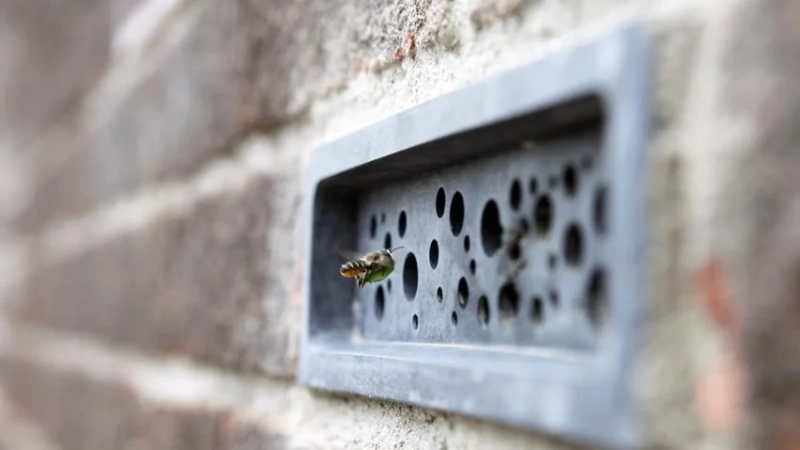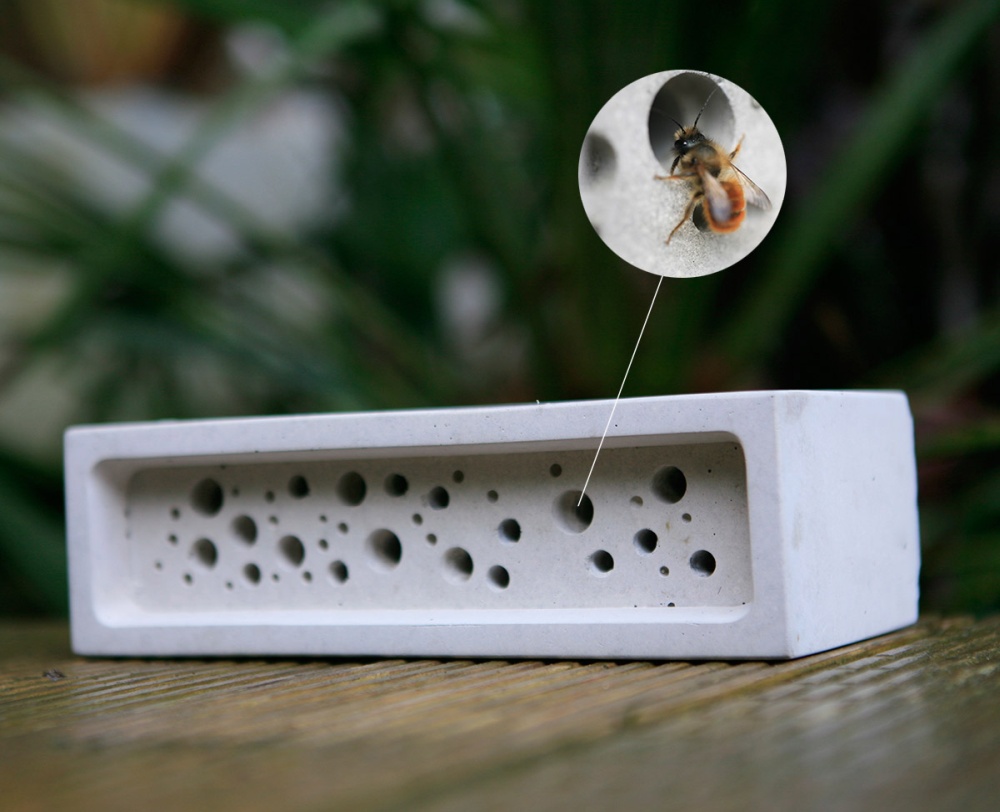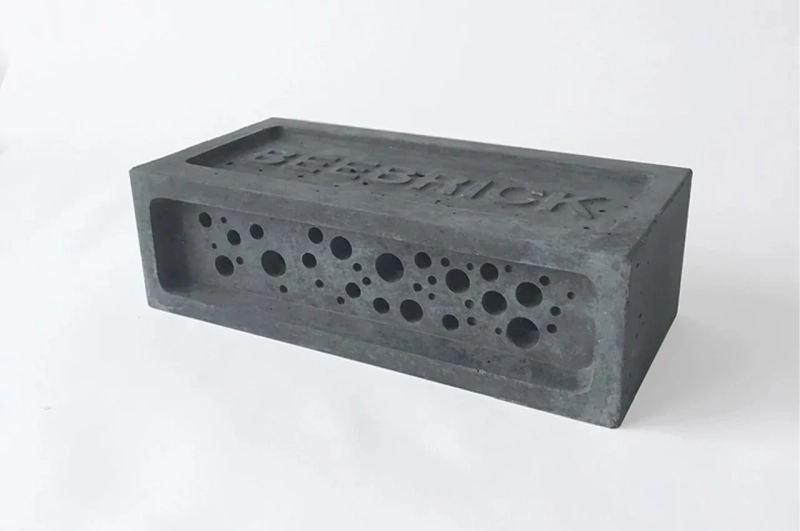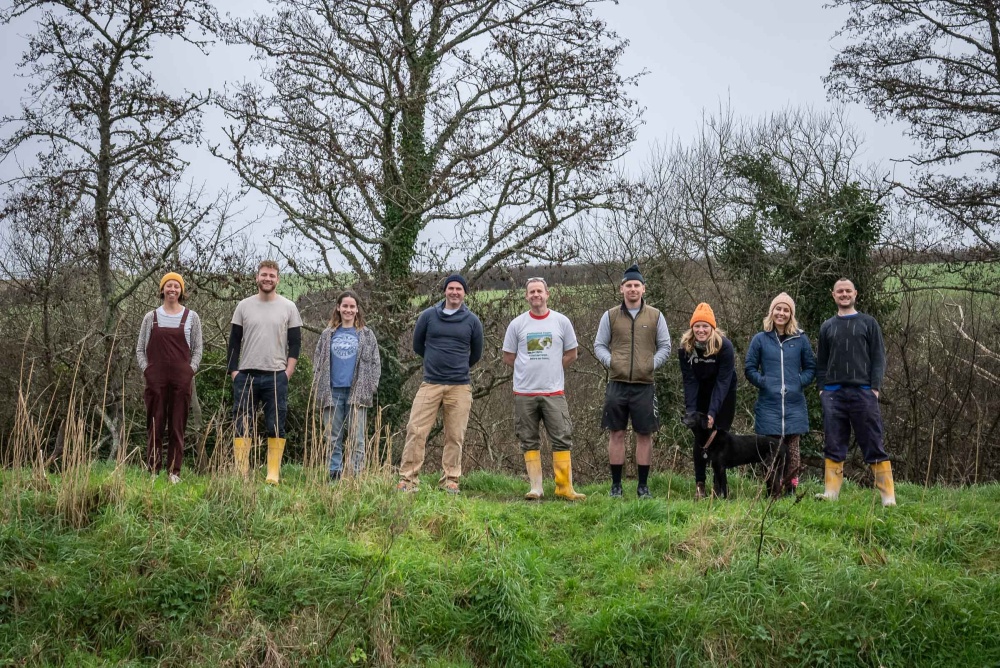The Bee Brick, solitary bee house, has garnered a lot of praise and criticism in the past few months. Some hailed it as an excellent move to help protect the bee population while others despised it as a disaster that could make matters worse for bees if the holes are uncleanable. The whole discussion unfolded after the Brighton and Hove Council – understanding the benefits of these bricks – called for all new buildings to include the special bricks in their construction.
Bee Bricks by Green&Blue are perfectly suited for non-swarming solitary bees like red masons and leafcutters. These are of the same size as regular bricks with a series of narrow openings that resemble spaces where solitary bees are known to nest. In order to understand how the Bee Bricks work and how the idea came about, we got in touch with Gavin Christman, founder of Green and Blue who obliged us with insight into the project and the controversy surrounding the creation.
Homecrux (HC): Thanks for your time Gavin. Tell us a little about your design studio Green and Blue?
Gavin Christman (GC): We’re a cornish company based by the coast on a mission to make homes havens for wildlife. We try and find solutions to some of the problems facing our wildlife species by using design and creating habitat and feeding stations that work for wildlife and that also look great for homeowners.
HC: Your studio name seems inspired by the colors of nature. If you’d like to share the background story of how it all started?
GC: I founded Green&Blue with my wife Kate back in 2004 and our name comes from childhood memories of piling into an old landrover and heading on holiday to Cornwall, waking to rolling green hills and blue skies. Nature and Cornwall have always been big influences for me and when we founded Green&Blue we took the leap and moved to Cornwall to run the business.
HC: You and your wife worked with Dyson before founding your own company? How did it help you in designing your own product?
GC: Dyson gave me a real insight into problem solving and into an innovative manufacturing environment. The company was very much about design and R&D and was the perfect place to learn about these things. As more of the business was moved out of the UK it also made me more determined and committed to keeping our product range at Green&Blue made in Britain.
HC: Was it always in the back of your head to run your own design studio because leaving a brand like Dyson must have been hard?
GC: My wife and I have always been passionate about nature and about the great outdoors and so there was always a longing to follow that passion and to make a difference in the world. I learnt so much at Dyson which I’ll always be grateful for and those lessons have followed me into the work we do at Green&Blue.
HC: What challenges did you face in the initial years of starting your business, considered people were ‘not really’ environment oriented?
Gavin Christman: There have certainly been challenges across the many years I’ve been running Green&Blue but they are nothing to the challenges facing our natural world and so that will always drive us on through difficult days, knowing that we are making a real difference in the world means we can face any obstacles that come our way!
HC: When and how did the concept of Bee Bricks come about?
GC: As I said, our range is about solving problems with design. As we learnt more about solitary bees and about how they had historically nested in old brickwork and crumbling mortar, alongside their natural habitat like plant stems and wood, the inspiration for Bee Brick was born. We recognized the scale of construction happening across the globe and thought if every one of those houses could make space for nature we could see real change in habitat.

HC: E.com websites like Amazon lists tons of products for housing bees. How is Bee Bricks different from other beehives being sold online? How’s your product doing in terms of online sales and popularity?
GC: Bee Bricks are designed for solitary bees rather than honey or bumble bees. Solitary bees don’t have a queen, don’t make honey and don’t live in hives but they are superb pollinators, and because they don’t have anything to protect they aren’t really aggressive meaning they’re safe to encourage around homeowners etc. Anything we can do in our garden to support nature is wonderful, Bee Bricks aren’t designed to replace that they’re designed to ensure that habitat is grown with construction rather than lost. Bee Brick has had a lot of press attention due to its innovative nature and we’ve been receiving inquiries from across the globe as a result – exciting for our little cornish company!
HC: Shed some light on the functioning of Bee Bricks. How do they help in maintaining the ecological balance?
GC: Bee Bricks create space for solitary bees to nest. They’ll lay an egg in a cavity and provision it with nectar and pollen and then partition that with chewed mud or leaf depending on the species, they might lay 6 or 7 eggs in a cavity and might use 3 or 4 cavities and then they die, the babies stay in the brick until the following spring when they emerge and repeat the cycle. During that time they will be very busy pollinating as they nest.

HC: What is the probability of bees colonizing these bee bricks?
GC: With nature, there are never guarantees, sometimes bees can move in almost straight away sometimes it can take a couple of years, there are lots of factors influencing this, availability of natural habitat and natural food sources, number of bees around – so many things can affect.
HC: Talking about the dimensions of the holes that act as a passage for bees, is it suitable for all species of bees?
GC: Bee Bricks are designed predominantly with cavity nesting species like red masons and leafcutters in mind. With all the attention from other parts of the world at the moment, we know more research would have to be done into different species across the globe before looking to launch elsewhere.

HC: How does one clean the cavities since removing the bricks time and again isn’t possible. And if there is no proper cleaning, there are chances of the bee brick turning into a house for wasps and spiders. How do you see that?
GC: There are mixed opinions on the subject of maintenance when it comes to your bee hotel and it is an area that will be closely studied as part of our coming data project. The Green&Blue bee house range takes inspiration from the way that solitary bees have created their nests in brickwork and crumbling mortar for many years with minimal interference from humans. Bees are naturally selective about where they nest and will often clear an area before going about their nesting activity. The Green&Blue range is about creating habitat for wildlife species where otherwise there would be literally no home for nature – such as in the walls of new builds. If people do wish to clean there are guides on our website and lack of cleaning will not turn them into a home for wasps and spiders. Solitary wasps may use the bricks but they’re actually really good pollinators too.
HC: You’ve garnered a lot of attention since Brighton and Hove Council passed the law requiring new buildings to use Bee Bricks. How does it impact your future sale? Do you plan to go worldwide or just focus on UK sales?
GC: At the moment we’re focused on the UK as we need to understand species worldwide to be able to best serve other markets. But eventually, we’d like to work globally to be part of the response to the climate emergency.

HC: Any other project(s) in the pipeline and when can we expect to see them?
GC: As a company, our mission is to make homes havens for wildlife so you can certainly expect more from us soon to support this. Our natural world is in trouble and it needs our help so we’re 100% focused on this mission.
HC: Words of wisdom to entrepreneurs and budding designers?
GC: Be brave, be bold, be clever, consider planet at the heart of everything you do and be kind!


We would like to thank Gavin Christman and the entire team of Green&Blue for taking the out time to chat with us. A special thanks to Faye for arranging the interview.
Follow Homecrux on Google News!




